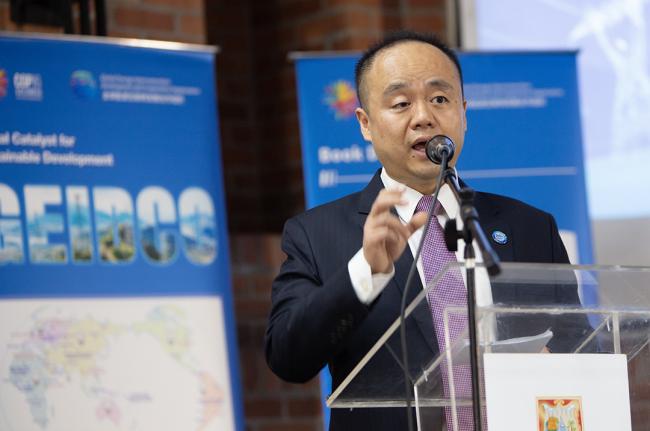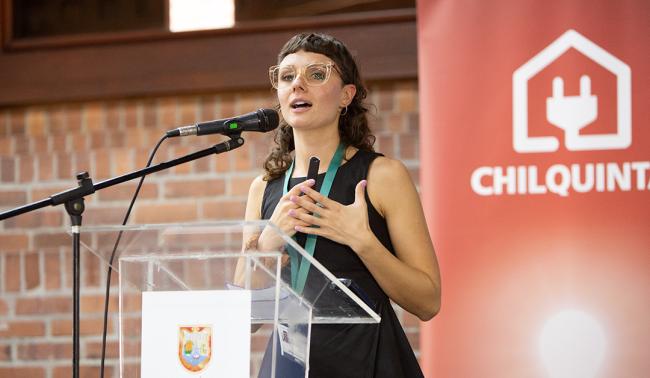About
The energy industry powers many businesses and much of society but puts immense pressure on the environment. As such, the move towards clean energy requires initiatives to ensure that biodiversity and ecosystem integrity are conserved. Efforts towards energy transition should not exclude biodiversity conservation – rather, they should work concomitantly to ensure the best synergies that benefit the climate-biodiversity-nexus.
The energy transition should not come at the expense of biodiversity conservation. This was a key message of the Forum on Energy Transition Promoting Biodiversity Conservation, where attendees were presented with different ways transition into clean energy can be harmonized with the goals of biodiversity conservation.
Jinyu Xiao, Global Energy Interconnection Development and Cooperation Organization (GEIDCO), opened the event, introducing it as an avenue to build consensus on establishing coordinated governance for energy transition, climate change mitigation, and biodiversity conservation.
In his opening remarks, Liu Zehong, GEIDCO, emphasized that energy transition will require transformation in how we produce, use, and distribute energy. He underscored that we need to find ways for the energy industry to work in harmony with nature.
Guomei Zhou, Ministry of Ecology and Environment, China, said that this forum could bring together wisdom to promote collaborative governance, biodiversity conservation, and the energy transition.
Carlos Adrián Correa, Mining and Energy Planning Unit, Colombia, described his unit’s mission to guide Colombia towards a sustainable energy model. He further outlined their plan, “Mission Transmission,” to modernize the country’s electrical network.
Hongyu Lin, GEIDCO, presented GEIDCO’s Report on the Coordinated Governance of Energy, Climate, and Biodiversity, outlining: the connection between energy, climate, and biodiversity; a systematic programme for ending climate change and conserving biodiversity through energy transition; measures for biodiversity conservation in energy and power project construction; and policy suggestions for coordinated governance of energy, climate, and biodiversity.
Xiao then presented the List of Energy Transition for Biodiversity, which showcases 10 projects (selected from over 130 global projects) that were recognized for their innovation and effectiveness, not only for biodiversity conservation, but also for their role in engaging more businesses in ecological conservation.
Virginia Castellucci, 3Bee, shared an example of such a project. She explained that 3Bee protects biodiversity through technology facilitating biodiversity monitoring and regeneration. She emphasized that technology is a key asset for a sustainable energy future.
Manuel Rodriguez Becerra, Emeritus Professor at the University of the Andes and Colombia’s first Minister of Environment, noted that while Colombia’s highest priority is to stop emissions from soil use or deforestation, the energy transition still forms an important part of Colombia’s efforts to address the impacts of climate change.
Jeffrey Sachs, UN Sustainable Development Solutions Network, underscored that the issues of climate change and biodiversity are closely intertwined, and said a holistic solution to sustainable development challenges, particularly Sustainable Development Goals (SDGs) 7 (affordable and clean energy), 13 (climate action), and 15 (life on land), can enable us to build the future we want.
Tim Scott, UN Development Programme (UNDP), said that UNDP fully supports the objectives of this forum and shared that integrated solutions in the design and implementation of climate and biodiversity strategy are vital. He reiterated UNDP’s commitment to ensuring that common energy and biodiversity issues are successfully addressed.
Helen Ding, World Resources Institute Europe, looked forward to more collaborations through business innovations and technological solutions, saying these are important to transforming the ways in which energy is produced, consumed, and distributed.
Lan Hong, Eco-Finance Research Center, Renmin University of China, outlined the coordination review between new energy and biodiversity conservation, emphasizing that these should be included in the due diligence of businesses.
In closing, Xiao thanked the speakers for sharing their thoughts and expertise, and said he hoped attendees were inspired by the diverse ways energy transition and biodiversity conservation can progress together, within businesses and the society.
Organizer: GEIDCO
Contact: Jin Chen, GEIDCO, chen-jin@geidco.org
For more information:
https://special.geidco.org.cn/241025/index/template/en.html#part1
To receive free coverage of global environmental events delivered to your inbox, subscribe to the ENB Update newsletter.
All ENB photos are free to use with attribution. For the 2024 UN Biodiversity Conference, please use: Photo by IISD/ENB | Angeles Estrada Vigil






















